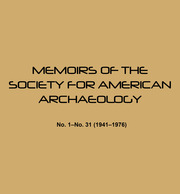No CrossRef data available.
Article contents
5 Comparisons, Contrasts, and Conclusions
Published online by Cambridge University Press: 27 June 2018
Extract
Before noting traits shared by the Arnipik and Tyara assemblages, a few words of caution and explanation may prove useful. I hope they will remain alive in the reader's mind as he examines the three closely related conclusions presented in this chapter. The three conclusions are, in order, a preliminary conclusion of restricted application, an intermediate conclusion of wider import, and a final conclusion of general consequence to this study. These conclusions' ranges of consequence increase as the discussion expands to encompass broader reaches of evidence and thinking pertinent to the question of Dorset culture origins. First, I have assumed, for previously presented or self-evident reasons, that the Tyara and Arnapik assemblages are pure assemblages, that is, that neither contains artifacts made by peoples of other cultures. Second, since the Arnapik material comprises only stone artifacts, comparison between that site and the bone, antler, and ivory artifacts from Tyara is precluded.
- Type
- Research Article
- Information
- Copyright
- Copyright © Society for American Archaeology 1968
References
Notes
1. Since his own words are sometimes reproduced here perhaps I should note that Meldgaard has applied the term Sarqaq to all Pre-Dorset remains in the eastern Arctic and Greenland rather than restricting it to the late Pre-Dorset variant about Disko Bay. That more narrow usage is employed by Collins, Harp, Larsen, Lowther, Maxwell and me. Meldgaard's usage could cause confusion and might one day be rejected on typological grounds; conversely, Pre-Dorset is a crude and awkward term. Surely a new name should be adopted for the Canadian-Greenland branch of the Arctic Small Tool Tradition to replace the term Pre-Dorset. Such might well be Scandinavian to recall the pioneer work of Solberg and his successors, Mathiassen, Larsen, Knuth, Meldgaard, and Mosegaard. It should also be short, distinctive, unbiased, easily spelled and readily pronounced. A new name might also recognize the debt of so many Eskimologists who have gleefully escaped an agony of translation in their thirst for knowledge. Could “Carlsberg culture” be accepted?


